Pragya tested the solubility of three different substances at different temperatures and collected the data as given below (results are given in the following table as grams of substance dissolved in 100 grams of water to form a saturated solution).
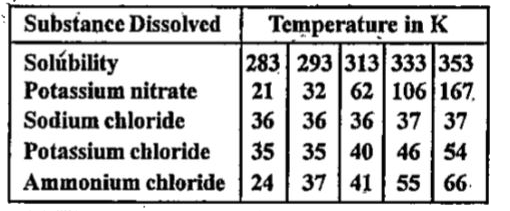
(a) What mass of potassium nitrate would be needed to produce a saturated solution of potassium nitrate in 50 grams of water at 313 K?
(b) Pragya makes a saturated solution of potassium chloride in water at 353 K and leaves the solution to cool at room temperature. What would she observe as the solution cools ? Explain.
( c) Find the solubility of each salt at 293 K. Which salt has the highest solubility at this temperature ?
(d) What is the effect of change in temperature on the solubility of a salt?
(a) At 313 K, 62 g of potassium nitrate is added to 100g of water to form a saturated solution. Therefore, mass of potassium nitrate needed to produce its satu-rated solution in 50 g of water at 313 k = 62100×50g
= 31g
(b) As the solution cools, Pragya oil observe that potassium chloride is crystallised.
( c) Solubility = Mass of soluteMass of solution×100
∴ Solubility of potassium nitrate at 293 K
= 32100+32×100
= 32132×100=24.24%
Solubility of sodium chloride at 293 K
= 36100+36×100
= 36136×100=26.47%
Solubility of potassium chloride at 293 K
= 35100+35×100
= 35135×100=25.92%
Solubility of ammonium chloride at 293K
= 37100+37×100
= 37137×100=27.01%
∴ Ammonium chloride has the highest solubility at 293K.
(d) Solubility of a salt increases with the increase in temperature.
Topper's Solved these Questions
- IS MATTER AROUND US PUREBOOK - SWAN PUBLICATIONCHAPTER - IS MATTER AROUND US PUREEXERCISE - IMPORTANT Q/A
16 Videos
- IS MATTER AROUND US PUREBOOK - SWAN PUBLICATIONCHAPTER - IS MATTER AROUND US PUREEXERCISE - IMPORTANT Q/A
16 Videos
- ATOMS AND MOLECULESBOOK - SWAN PUBLICATIONCHAPTER - ATOMS AND MOLECULESEXERCISE - IMPORTANT Q/A
27 Videos
- MATTER IN OUR SURROUNDINGS BOOK - SWAN PUBLICATIONCHAPTER - MATTER IN OUR SURROUNDINGS EXERCISE - IMPORTANT Q/A
15 Videos
Similar Questions
Pragya tested the solubility of three different substances at different temperatures and collected the data as given below (results are given in the following table, as grams of substance dissolved in 100 grams of water to form a saturated solution).
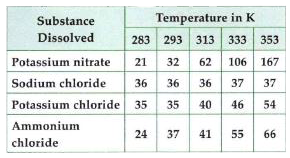
What mass of potassium nitrate would be needed to produce a saturated solution of potassium nitrate in 50 grams of water at 313 K?
View SolutionPargya tested the solubility of four different substances at different temperatures and collected the data as given below (results are given in the following table as grams of substance dissolved in 100 grams of water to from a saturated solutin).

(a) What mass of potassium nitrate would be needed to procuce a strurated solution of potassium nitrate in 50 grams of water at 313 K ?
(b) Pragya makes a saturated solution of potassium chloride in water at 353 K and leaves the solution to cool at room temperature. What would she observe as the solution cools ? Explain.
(c ) Find the solubility of each salt at 293 K. Which salt has the highest solubility at this twmperature?
(d) What is the effect of change in temperature on the solubility of a salt ?
View SolutionPragya tested the solubility of three different substances at different temperatures and collected the data as given below (results are given in the following table, as grams of substance dissolved in 100 grams of water to form a saturated solution).
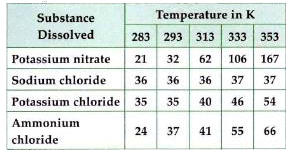
What is the effect of change of temperature on the solubility of a salt?
View SolutionPragya tested the solubility of three different substances at different temperatures and collected the data as given below (results are given in the following table, as grams of substance dissolved in 100 grams of water to form a saturated solution).
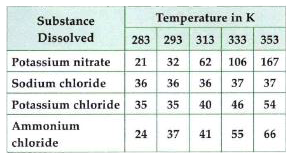
Find the solubility of each salt at 293 K. Which salt has the highest solubility at this temperature?
View SolutionPragya tested the solubility of three different substances at different temperatures and collected the data as given below (results are given in the following table, as grams of substance dissolved in 100 grams of water to form a saturated solution).
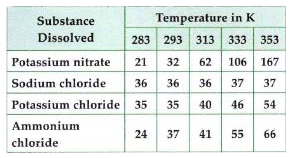
Pragya makes a saturated solution of potassium chloride in water at 353 K and leaves the solution to cool at room temperature. What would she observe as the solution cools? Explain.
View SolutionSolubility of KNO3at 313 K is 62 g. What mass of KNO3 would be needed to produce a saturated solution of KNO3 in 50 g of water at 313 K ?
View Solution4 g of a solute are dissolved in 40 g of water to form a saturated solution at 25∘C. Calculate the solubility of the solute.
View SolutionA student , determined the solubility of four substabces ,potassium nitrate ,sodium , sodim choride ,potassium choride and ammonium choride in a water at five different temperatures of 10∘C,20∘(C40∘C,60∘C and 80∘C and obtained the following data :

(a) what mass of potassium nitrate woulds be needed to make a satured solution of potassium nitrate in 50 grams of water at 40∘C? (b) what would be observed if a saturated solution of potassium choride at 80∘C is left to cool to the room temperature ?
( c) what is the solubilty of each salt at 20∘C ? which salt has the highest solubility at this temperature ?
(d) what is the effect of change of temperature on the solbubility of a salt as shown by the above date?
View SolutionAnkita tested the solubility of four different substances (I-IV) at different temperatures and collected the data as given in the table.

Fill in the blanks by selecting the correct option. __(x)___ of substance III would be needed to produce a saturated solution of it in 50 grams of water at 40∘C. ___(y)___ has the highest solubility at 20∘C while ___(z)___ has the least solubility at 10∘C.
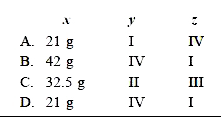
View SolutionExplain why hot saturated solution of potassium nitrate forms crystals as it cools.
View Solution
